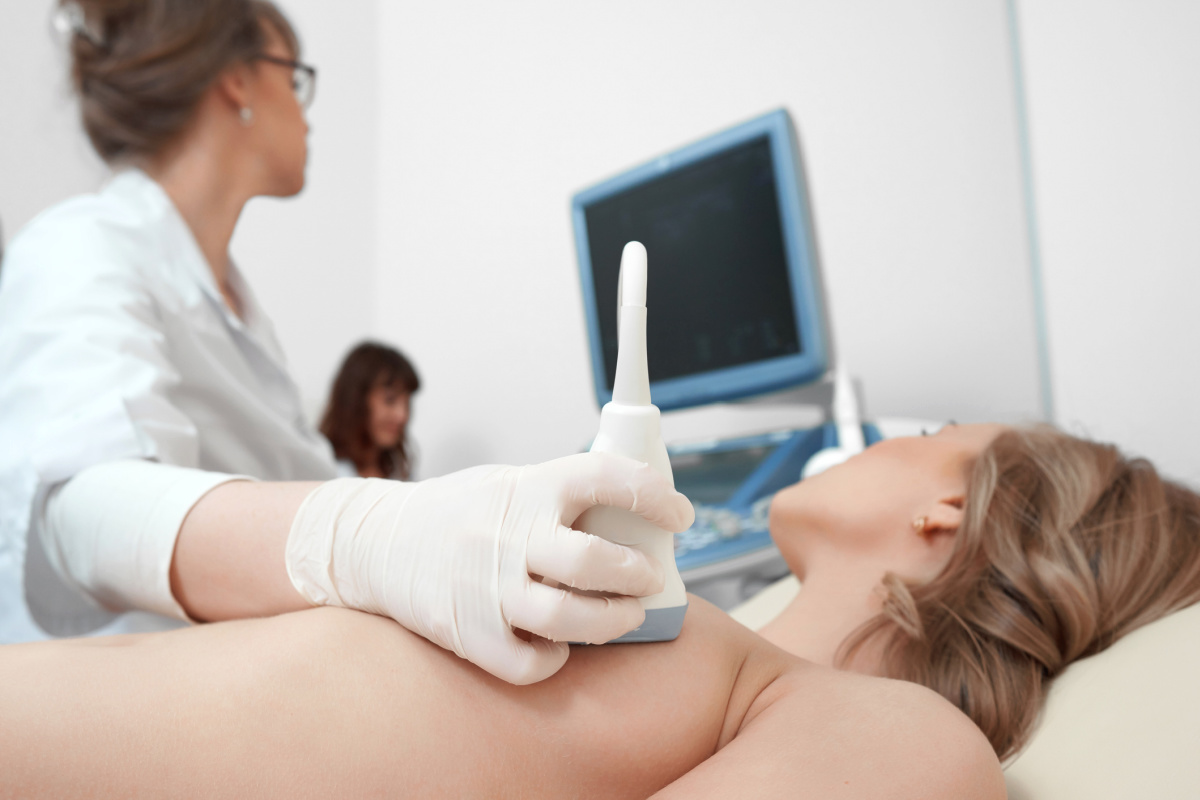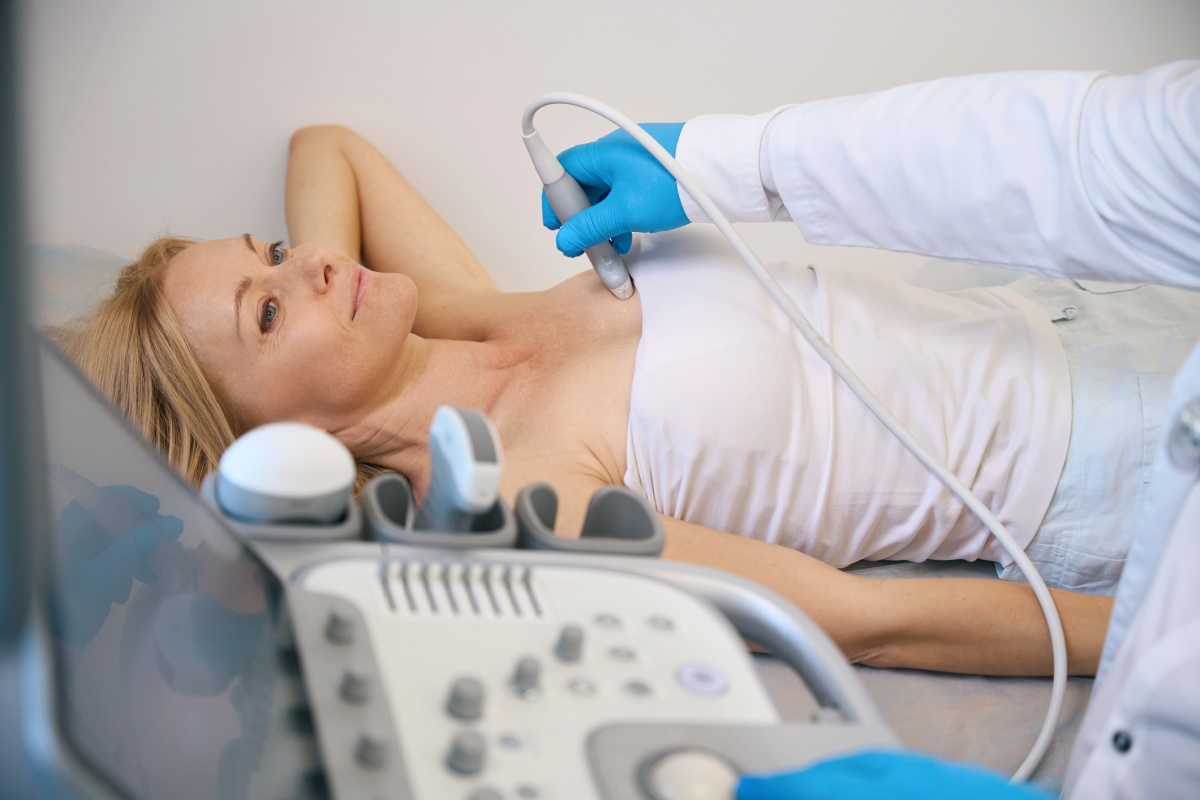Ultrasound for Breast Implant Surveillance: 6 FAQs, Answered

Breast implants are long-lasting, but like any medical device, they are not designed to last a lifetime. An implant can weaken over time, leading to rupture, especially with older implants. The rate of rupture of silicone implants at 10 years is anywhere from 5-13%, depending on the brand and type of implant.
Dr. Emily Kirby offers complimentary ultrasound surveillance as a part of ongoing care for her breast augmentation patients. Those who have had surgery elsewhere are welcome to have their implants scanned for a fee. Here’s what you need to know about breast implant surveillance using ultrasound in Fort Worth.
What is an implant rupture, and why is detection important?
A breast implant rupture occurs when the implant’s outer shell develops a tear or hole. A ruptured saline implant is immediately noticeable because the implant deflates and the saline solution (sterile salt water) is safely absorbed by the body, typically within days. With silicone implants, a rupture may not cause obvious changes, which is why it is often called a “silent rupture.”
The FDA recommends routine imaging of silicone breast implants starting 5-6 years after surgery, then every 2-3 years after that. If a rupture is suspected, it can be identified early and addressed before issues arise.
Routine ultrasound imaging helps patients feel confident about their implant health and allows for early detection of implant issues and timely intervention, if needed.
What are the signs of a silicone breast implant rupture?
Silicone implant ruptures may not cause noticeable changes right away. However, some women experience symptoms such as:
- Changes in breast shape or size. One breast may appear smaller, uneven, or distorted.
- Firmness or hardening. The breast may feel firmer due to thickened scar tissue around the ruptured implant (capsular contracture).
- New lumps or swelling. A rupture may trigger localized inflammation or fluid buildup.
- Discomfort or pain. Some women experience aching, tenderness, or a heavy feeling in the affected breast.
Even if you don’t have symptoms, regular ultrasounds can help detect silent ruptures before they become a concern.
How does ultrasound detect a ruptured breast implant?
Ultrasound imaging uses sound waves to create detailed pictures of soft tissues, making it an excellent tool for evaluating breast implants. During an ultrasound scan, the ultrasound is moved across the breast, sending painless sound waves into the tissue. These waves bounce back and create an image on a screen in real time and reveal any irregularities such as ruptures, ripples, leaks, or changes in the implant’s structure.
Will a mammogram detect a breast implant rupture?
Routine mammograms are recommended starting at age 40 (or earlier, based on your family history) to monitor breast tissue, but mammograms are not ideal for imaging implants, and may miss signs of rupture, as the focus is on breast tissue and not the implant.

What happens if a rupture is detected?
Dr. Kirby discusses the ultrasound findings with you right away. If an ultrasound reveals a possible implant rupture, the next steps may be a more detailed evaluation with an MRI or a consultation to discuss revision surgery. A ruptured implant is not an emergency, but it does mean that plans should be made to remove or replace your implants. Most major implant companies offer a lifetime warranty for implant ruptures, offering replacement implants for no charge.
Dr. Kirby walks you through your options, which may include one or more of the following procedures:
- Implant exchange (secondary breast augmentation) to replace the ruptured implants with new ones.
- Implant removal (explantation) to remove both implants, if you no longer wish to have them.
- Breast lift (mastopexy) if needed, to restore shape and firmness after implant removal or implant exchange.
- Capsulectomy (removal of excess scar tissue), if the scar tissue holding the implant is abnormally thickened or hardened.
Dr. Emily Kirby prioritizes safety and personalized care. If you require surgical correction, she works closely with you to achieve results that align with your aesthetic goals.
What are the benefits of ultrasound screening for breast implants?
Using ultrasound for breast implant monitoring provides several advantages:
Early detection of ruptures
While a rupture may not immediately affect breast shape or comfort, over time it may cause inflammation, pain, or changes in breast appearance. Dr. Kirby understands that detecting an issue early with ultrasound allows corrective action to be taken before complications arise and promotes the best possible outcome.
Peace of mind with immediate results
Many women with silicone breast implants worry about silent ruptures and feel uncertain about their implants’ integrity, especially as the years pass. One of the biggest advantages of ultrasound screening is that results are immediately available. MRI scans require scheduling, uncomfortable positioning, image processing, and separate radiology interpretation (which can take days or even weeks). At Kirby Plastic Surgery, Dr. Kirby personally reviews the images during your appointment to confirm your implant status, eliminating the stress of waiting.
Ultrasound screenings at Kirby Plastic Surgery ensure you receive an expert evaluation and results in a single visit for low-stress and convenient silicone breast implant monitoring.
Non-invasive and painless
Unlike other imaging methods, ultrasound is completely non-invasive and does not require compression, needles, or any uncomfortable positioning. Most screenings take 30 minutes or less, making them a quick and stress-free part of routine implant maintenance. Since there is no downtime or discomfort, patients can immediately return to their daily activities after the scan.
No radiation exposure
Ultrasound imaging is a radiation-free imaging technique. This makes it a safe, repeatable option for long-term breast implant monitoring without concerns about cumulative radiation exposure. Since the FDA recommends repeat imaging every 2–3 years, ultrasound is a particularly beneficial choice for women who prefer a safer, lower-risk approach to ongoing breast implant care.
More convenient and cost-effective than MRI
Magnetic Resonance Imaging (MRI) was historically considered the gold standard for implant rupture detection, but it comes with a significant financial and logistical burden. MRIs are expensive, and many insurance providers do not cover the procedure unless a patient has symptoms of a rupture. Additionally, not all patients are eligible for an MRI. Those with pacemakers, certain metal implants, or severe claustrophobia may not be able to undergo the procedure. With newer high-resolution ultrasound technology, many recent studies have shown that high-resolution ultrasound is now superior to MRI for breast implant surveillance.
Many imaging centers require a physician’s referral before performing breast implant screenings, creating extra steps, longer wait times, and additional costs. An ultrasound’s affordability makes it ideal for routine checks; if Dr. Kirby detects an issue, then an MRI can be used to confirm the result, if needed.
Dr. Kirby offers in-office ultrasound screenings for her breast augmentation patients at no cost. If you had implants placed elsewhere previously, Dr. Kirby provides ultrasounds for a fee that may be applied toward your surgery with her.
Schedule your breast implant ultrasound in Fort Worth
Routine implant monitoring is an essential part of maintaining your breast health and aesthetic results. Board-Certified Plastic Surgeon Dr. Emily Kirby provides expert ultrasound screenings to help you stay informed and proactive about your breast implants.
Call or text (817) 292-4200 to schedule your breast implant ultrasound at our Fort Worth plastic surgery center today.


